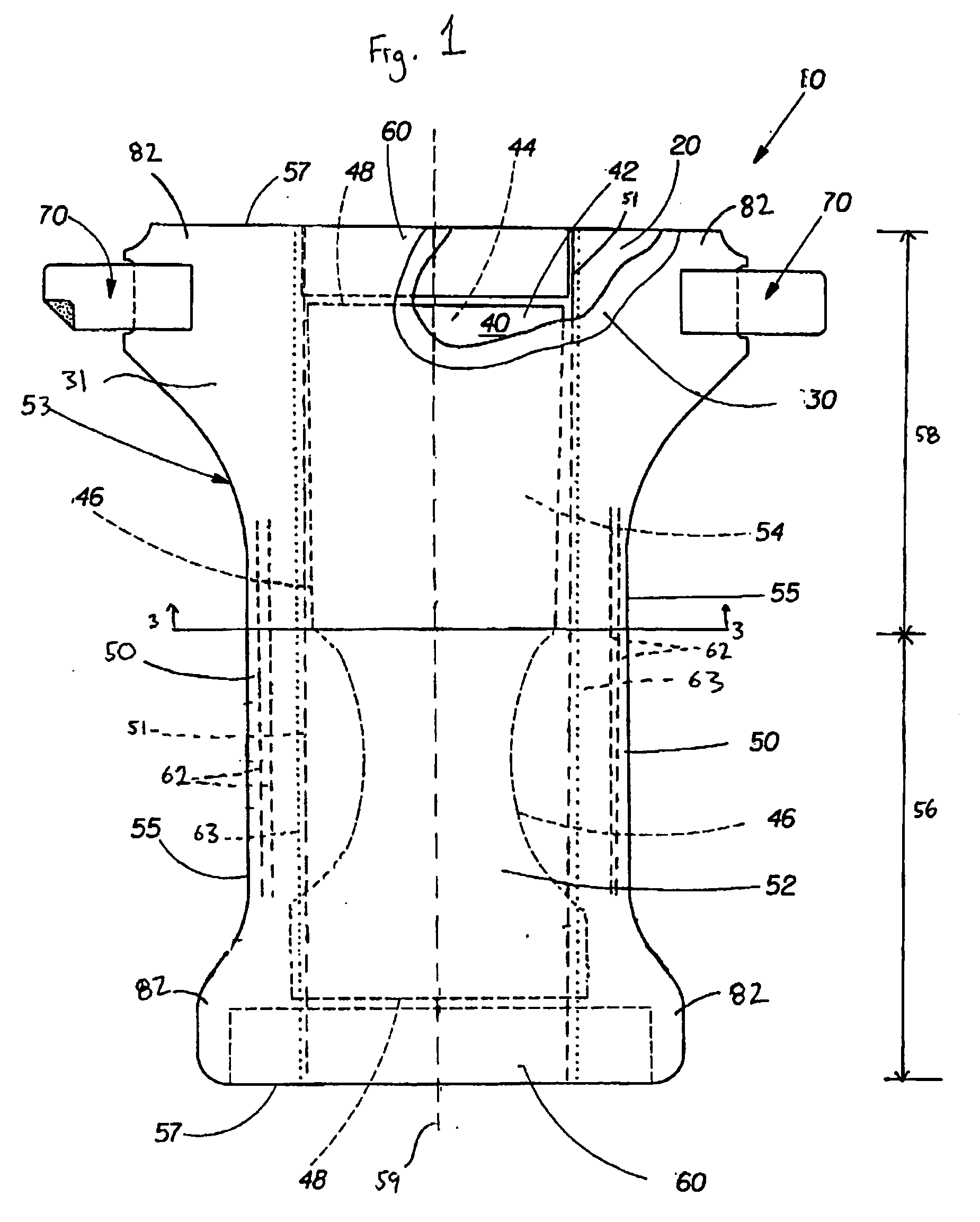Hydrophobic surface coated light-weight nonwoven laminates for use in absorbent articles
a technology of nonwoven laminates and hydrophobic surfaces, applied in the field of absorbent articles, can solve the problems of inability to meet the needs of materials, body exudates escaping the boundaries of the article, and the absorbent article is still prone to failur
- Summary
- Abstract
- Description
- Claims
- Application Information
AI Technical Summary
Benefits of technology
Problems solved by technology
Method used
Image
Examples
example 1
[0109] A hydrophobic surface coating of the present invention is prepared by spraying, dipping, or employing a kiss-roll process of an aqueous mixture of vinyl terminated polydimethyl siloxane and methylhydrogen polydimethyl siloxane in a 30:1 ratio in order that at least about 400 μg / g of the aqueous silicone mixture is deposited on the substrate. Suitable substrates for use in this example include the light-weight nonwoven laminates having a spunbond / meltblown / spunbond laydown in gsm of 6 / 1 / 6. 7 / 1 / 7, and 8 / 1 / 8. The light-weight nonwoven laminates are commercially available from various suppliers. The aqueous mixture also contains a transition metal catalyst to facilitate the self-crosslinking of the PDMS polymers. The wet coated substrate is dried at 120° C. for 0.5-1.0 minutes and is then stored in a suitable container for later use.
example 2
[0110] A nonwoven diaper cuff component treated with a hydrophobic surface coating is prepared. A 3% solution of a vinyl terminated PDMS (commercially available from GE Silicones as SM3200) and a methyl hydrogen PDMS (commercially available from GE Silicones as SM3010) is prepared and mixed for 30 minutes. A typical leg cuff material, such as the light-weight nonwoven laminates disclosed in Example 1, is dipped into the solution and the excess liquid squeezed out in order that approximately at least about 400 μg / g of the aqueous silicone mixture is deposited on the nonwoven laminate. The cuff material is dried as described in Example 1 and is incorporated into a diaper constructing in a similar manner to the diaper detailed in U.S. Pat. No. 6,420,627. (Particularly, the cuff design of the present example is substantially similar to the cuff design in FIG. 3 of U.S. Pat. No. 6,420,627. The meltblown nonwoven web (92) of U.S. Pat. No. 6,420,627 is substituted with the hydrophobic surf...
example 3
[0111] A nonwoven diaper cuff and / or outer cover component treated with a hydrophobic surface coating is prepared. A 3% solution of a hydroxyl terminated PDMS (commercially available from GE Silicones as SM2245) and a methyl hydrogen PDMS (commercially available from GE Silicones as SM2014c) is prepared and mixed for 30 minutes. A typical leg cuff and / or outer cover material, such as the light-weight nonwoven laminates disclosed in Example 1, is dipped into the solution and the excess liquid squeezed out in order that approximately at least about 400 μg / g of the aqueous silicone mixture is deposited on the nonwoven laminate. The cuff and / or backsheet components are dried at 120° C. for 0.5-1.0 minutes and incorporated into a diaper constructing in a similar manner to the diaper detailed in U.S. Pat. No. 6,420,627. (Particularly, the cuff design of the present example is substantially similar to the cuff design in FIG. 3 of U.S. Pat. No. 6,420,627. The meltblown nonwoven web (92) of ...
PUM
 Login to View More
Login to View More Abstract
Description
Claims
Application Information
 Login to View More
Login to View More - R&D
- Intellectual Property
- Life Sciences
- Materials
- Tech Scout
- Unparalleled Data Quality
- Higher Quality Content
- 60% Fewer Hallucinations
Browse by: Latest US Patents, China's latest patents, Technical Efficacy Thesaurus, Application Domain, Technology Topic, Popular Technical Reports.
© 2025 PatSnap. All rights reserved.Legal|Privacy policy|Modern Slavery Act Transparency Statement|Sitemap|About US| Contact US: help@patsnap.com



